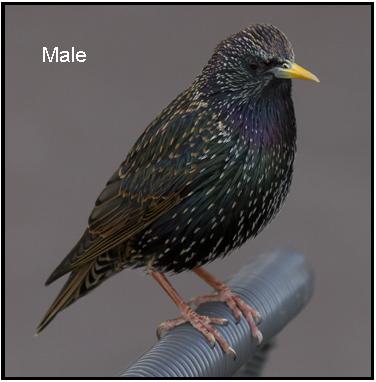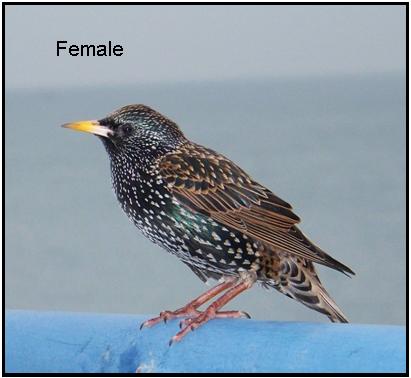If you feed the birds in your garden you may notice that the starlings busily barging other birds out of the way at the feeders are looking smarter than usual. This is because they are now in their breeding plumage and probably building a nest in your eaves, or a hole in a nearby tree. Although you may think they all look the same, take a closer look. In addition to the beautiful iridescent sheen in their feathers, the spots look a little clearer than usual – and the subtle difference in size and shape of these is one way of telling males from females. But you need to have the bird in your hand to see it! An easier way is to look at the area around the base of their bill. Nature has very conveniently colour-coded their gender: males are now pale blue, and females pale pink.


By the end of the month their eggs will have hatched and the queue-jumping at your feeders will increase as they struggle to find sufficient food to fill the four gaping mouths waiting for them back at the nest. Your feeders, however, are only their convenient neighbourhood fast-food outlet. If the adults can find them, leatherjackets (the larvae of daddy-longlegs) extracted from untreated lawns and rough grass are preferred.
Although starlings are a species many people love to hate, Mozart kept one as a pet – it seems he was astounded to hear one, on sale in a shop, that could whistle one of his recently composed, but unpublished, works. Until recently wild birds were popular as pets – Queen Victoria kept a bullfinch, for example – so it wasn’t surprising that Mozart enjoyed the company of one, especially as the species is known to be a good mimic.
Starlings also have a good sense of smell. For a long time it has been known that they add scented plants to their nests – possibly to help sanitise what becomes quite a foul-smelling environment as the chicks grow and soil the nest. Not surprisingly then, they also have a well-developed sense of taste and can sense salt, citric acid, tannins and sugars. They can even discriminate between sucrose and other kinds of sugar, possibly because they cannot digest sucrose (table sugar).
Meanwhile, observant visitors to the village church will also spot the difference in the holly tree on the right as you approach the church door – there is now a nest box on the trunk, just above head height. A second box has been added to the cedar tree beyond the chancel. The churchyard already has myriad niches in which small birds can nest in its many magnificent old trees, but there may be a pair that prefers new-build!
There is certainly a variety of species there – it was good to note the greenfinches, a species that has seen its population tumble in recent years due to a parasite that makes their throat swell and stops them from eating. Goldfinches were there a-plenty, along with mistle thrush and nuthatch – the former already in full song and possibly sitting on eggs in a nest hidden in a tree canopy. An old country name for them is ‘storm-cock’ because of their habit of singing into the teeth of gale from a tree top – just what one was doing on a blustery mid-March morning when I was there!







Make A Comment
Comments (0)